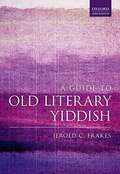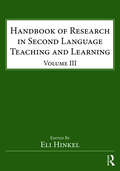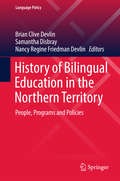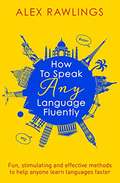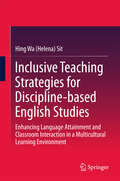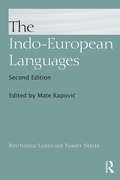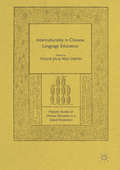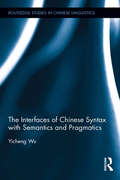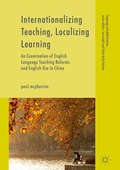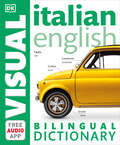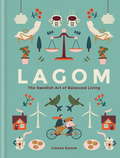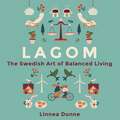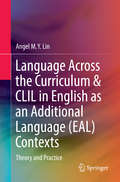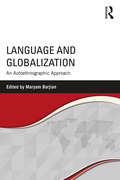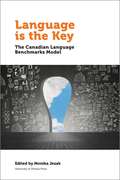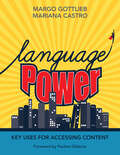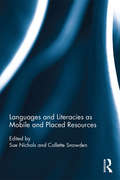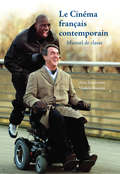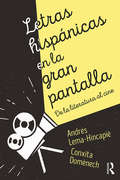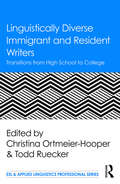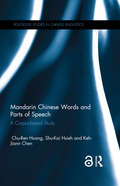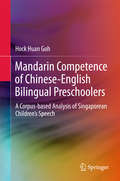- Table View
- List View
A Guide to Old Literary Yiddish
by Jerold C. FrakesThis book is a comprehensive introductory manual that guides beginners to a functional reading knowledge of late medieval and early modern Yiddish (c.1100-1750). It is the first such manual to exist for that language, whose early literary tradition comprises a range of genres as broad as other contemporary European literary traditions. <p><p>The guide is organized as a series of progressively more complex lessons, focused on key texts of the literary corpus, which are presented in their authentic form as found in manuscripts and early printed books. The lessons seek to accommodate readers ranging from absolute beginners to those who might already know Hebrew, medieval German, or modern Yiddish. The focal texts are the Old Yiddish midrashic heroic lay,'Joseph the Righteous', from the earliest extant manuscript collection of Yiddish literature (1382), the Middle Yiddish romance adventure tale, 'Briyo and Zimro', from a later collection (1585), and a full canto of the Middle Yiddish epic, Pariz and Viene (1594), each with full glosses and a step-by-step introduction to the morphology, syntax, and phonology. Each lesson also includes a brief supplemental text that cumulatively demonstrates the broad cultural range of the corpus. In addition, several appendices of supplementary material round out the volume, including a collection of additional readings, a table of the manuscript hands and printing fonts employed in the volume, and a full end-glossary of all Yiddish words found in the texts.
Handbook of Research in Second Language Teaching and Learning: Volume III (ESL & Applied Linguistics Professional Series)
by Eli HinkelVolume III of the Handbook of Research in Second Language Teaching and Learning, like Volumes I and II, is a comprehensive, state-of-the-art overview of current research into social contexts of second language (L2)/foreign language (FL) teaching and learning; language policy; curriculum; types of instruction; incremental language skills such as listening, speaking, reading, writing, vocabulary, and grammar; international communication; pragmatics; assessment and testing. It differs from earlier volumes in its main purpose—to provide a more in-depth discussion and detailed focus on the development of the essential language skills required for any type of communication: speaking, listening, reading, vocabulary, grammar, and writing. Volume III preserves continuity with previous volumes in its coverage of all the classical areas of research in L2/FL teaching and learning and applied linguistics, but rather than offering a historical review of disciplinary traditions, it explores innovations and new directions of research, acknowledges the enormous complexity of teaching and learning the essential language abilities, and offers a diversity of perspectives. Chapter authors are all leading authorities in their disciplinary areas. What’s new in Volume III? Updates the prominent areas of research, including the sub-disciplines addressed in Volumes I and II, and represents the disciplinary mainstays Considers and discusses perspectives held by different schools of thought on the what, the how, and the why of teaching foundational language skills, including theories, pedagogical principles, and their implementation in practice Captures new and ongoing developments and trends in the key areas of L2/FL teaching and learning, and innovative research topics that have gained substantial recognition in current publications, including the role of corpora, technology, and digital literacy in L2/FL teaching and learning Examines new trends in language pedagogy and research, such as an increased societal emphasis on teaching academic language for schooling, somewhat contradictory definitions of literacy, and the growing needs for instruction in intercultural communication.
History of Bilingual Education in the Northern Territory
by Brian Clive Devlin Samantha Disbray Nancy Regine Friedman DevlinThis book provides the first detailed history of the Bilingual Education Program in the Northern Territory of Australia. This ambitious and innovative program began in 1973 and at different times it operated in English and 19 Aboriginal languages in 29 very remote schools. The book draws together the grassroots perspectives of Indigenous and non-Indigenous practitioners and researchers. Each chapter is based on rich practitioner experience, capturing bottom-up aspirations, achievements and reflections on this innovative, yet largely undocumented language and education program. The volume also makes use of a significant collection of 'grey literature' documents to trace the history of the program. An ethnographic approach has been used to integrate practitioner accounts into the contexts of broader social and political forces, education policy decisions and on-the-ground actions. Language in education policy is viewed at multiple, intersecting levels: from the interactions of individuals, communities of practice and bureaucracy, to national and global forces. The book offers valuable insights as it examines in detail the policy settings that helped and hindered bilingual education in the context of minority language rights in Australia and elsewhere.
How to Speak Any Language Fluently: Fun, stimulating and effective methods to help anyone learn languages faster
by Alex RawlingsThis book will give you the skills to learn to speak any language with confidence. It uses techniques that can easily be incorporated into your daily life, while making use of whatever resources you have available. Whether you are starting out with your first foreign language or wishing to add to your repetoire, you'll find a wealth of easy-to-follow advice and achievable goals. Discover how to:-Speak with greater confidence and accuracy-Effectively learn vocabulary and grammar -Use time on the internet and social media to learn a language-Read real books, websites and articles in a foreign language-Pass exams that certify your language skills
How to Speak Any Language Fluently: Fun, stimulating and effective methods to help anyone learn languages faster
by Alex RawlingsThis book will give you the skills to learn to speak any language with confidence. It uses techniques that can easily be incorporated into your daily life, while making use of whatever resources you have available. Whether you are starting out with your first foreign language or wishing to add to your repetoire, you'll find a wealth of easy-to-follow advice and achievable goals. Discover how to:-Speak with greater confidence and accuracy-Effectively learn vocabulary and grammar -Use time on the internet and social media to learn a language-Read real books, websites and articles in a foreign language-Pass exams that certify your language skills
Inclusive Teaching Strategies for Discipline-based English Studies
by Hing Wa Helena SitThis book presents empirical findings that reveal various teaching strategies and responses from two sub-cultural groups of students, i. e. local Hong Kong and Mainland students, with regard to their English studies. It puts forward a constructive model for innovative teaching strategies to enhance language attainment and classroom interaction in a multicultural learning environment in Hong Kong. It highlights inclusive teaching strategies with instructional, inspirational and interactional components to accommodate diverse learners and promote their classroom interaction. In addition to contributing to innovation in higher education in Hong Kong, the lessons learned here can be universally applied to ESL/EFL teaching and education reform around the world. Further, they support better learning and teaching at universities in the context of internationalization. The book will above all benefit undergraduate students in ESL/EFL teacher training programs, and post-graduate research students in applied linguistics, language education and second language teacher education. It also offers a valuable reference book for university lectures in teacher education, researchers in higher education in China, and TESOL/TEFL instructors in English-speaking countries (the UK, USA, Canada, Australia, New Zealand etc. ).
The Indo-European Languages
by Mate Kapovi 263 Anna Giacalone Ramat Paolo RamatThe Indo-European Languages presents a comprehensive survey of the individual languages and language subgroups within this language family. With over four hundred languages and dialects and almost three billion native speakers, the Indo-European language family is the largest of the recognized language groups and includes most of the major current languages of Europe, the Iranian plateau and the Indian subcontinent. Written by an international team of experts, this comprehensive, single-volume tome presents in-depth discussions of the historical development and specialized linguistic features of the Indo-European languages. This unique resource remains the ideal reference for advanced undergraduate and postgraduate students of Indo-European linguistics and languages, but also for more experienced researchers looking for an up-to-date survey of separate Indo-European branches. It will be of interest to researchers and anyone with an interest in historical linguistics, linguistic anthropology and language development.
Integrated Chinese 1: Simplified Characters
by Yuehua Liu Tao-Chung Yao Nyan-Ping Bi Liangyan Ge Yaohua ShiNIMAC-sourced textbook
Interculturality in Chinese Language Education
by Tinghe Jin Fred DervinThis book calls for a change in the way interculturality is introduced in Chinese language education, while the demand for Chinese language teaching increases around the world. The concept of culture - as in the phrase 'Chinese culture' - has often been one of the main emphases of Chinese language education, providing students with facts about China and 'recipes' on how to meet Chinese people and how to behave like them. However, Chinese culture, like all cultures, does not constitute a closed system, but is constantly evolving and exchanging with other cultures. This unique volume comprises studies from around the world that promote intercultural awareness, dialogue, and encounters in Chinese language education. Written in a clear and readable style, this book will appeal to a diverse readership, from practising and training teachers of Chinese, to researchers interested in language and intercultural education.
The Interfaces of Chinese Syntax with Semantics and Pragmatics (Routledge Studies in Chinese Linguistics)
by Yicheng WuThe Interfaces of Chinese Syntax with Semantics and Pragmatics provides an in-depth exploration of a variety of interface phenomena in Chinese, a non-inflectional language, where to a large extent word order constrains its interpretation and defines its grammatical functions. Under the Dynamic Syntax approach, which takes the incremental left-to-right processing of linguistic forms to be a fundamental part of characterizing the relation between syntactic structure and semantic interpretation, a straightforward explanation is provided. The study features detailed analysis of a range of key grammatical constructions such as topic, passive, copular and cleft, where previous analyses were sought in pure syntactic, semantic or pragmatic terms. Clear and straightforward throughout, The Interfaces of Chinese Syntax with Semantics and Pragmatics will be of interest to graduate students and scholars of Chinese, linguistics and cognitive science.
Internationalizing Teaching, Localizing Learning
by Paul McpherronBased on ethnographic and policy data collected over a ten-year span at a university in the People's Republic of China, this book analyses the history of English Language Teaching (ELT) polices in Chinese higher education. The book uses the university as a lens in which to investigate the creative imaginations and divergent (re)appropriations of teaching methods, learning materials, and language use in the Chinese ELT context. Book chapters move beyond mere descriptions of tensions and point to the local understandings and practices of English teachers (both local and foreign) and students. Working together, these teachers and students are constantly articulating new social and political conditions and meanings outside and inside given discourses and traditions of ELT. The book's main argument is that these multiple stakeholders must be given a more prominent role in shaping policy and curriculum at universities and other English language contexts around the world.
Italian–English Bilingual Visual Dictionary (DK Bilingual Visual Dictionaries)
by DKNewly revised and updated, the Italian-English Bilingual Visual Dictionary is a quick and intuitive way to learn and recall everyday words in Italian. The Italian-English Bilingual Visual Dictionary introduces a range of useful current vocabulary in thematic order, using full-color photographs and artworks to display and label all the elements of everyday life — from the home and office to sport, music, nature, and the countries of the world — with panel features on key nouns, verbs, and useful phrases. The Italian-English Bilingual Visual Dictionary features: A quick and intuitive way to learn and remember thousands of words. A complete range of illustrated objects and scenes from everyday life. Fast and effective learning for any situation, from home and office to shopping and dining out. Detailed index for instant reference. Handy size ideal for travel. The illustrations in the Italian-English Bilingual Visual Dictionary provide a quick and intuitive route to learning a language, defining the words visually so it is easier to remember them and creating a colorful and stimulating learning resource for the foreign-language and EFL/ESL student.
Lagom: The Swedish Art of Balanced Living
by Linnea DunneStep aside Hygge. Lagom is the new Scandi lifestyle trend taking the world by storm. This delightfully illustrated book gives you the lowdown on this transformative approach to life and examines how the lagom ethos has helped boost Sweden to the No.10 ranking in 2017's World Happiness Report. Lagom (pronounced 'lah-gom') has no equivalent in the English language but is loosely translated as 'not too little, not too much, just right'. It is widely believed that the word comes from the Viking term 'laget om', for when a mug of mead was passed around a circle and there was just enough for everyone to get a sip. But while the anecdote may hit the nail on the head, the true etymology of the word points to an old form of the word 'lag', which means 'law'.Far from restrictive, lagom is a liberating concept, praising the idea that anything more than 'just enough' is a waste of time. Crucially it also comes with a selflessness and core belief of responsibility and common good. By living lagom you can: Live a happier and more balanced life Reduce your environmental impact Improve your work-life balance Free your home from clutter Enjoy good food the Swedish way Grow your own and learn to forage Cherish the relationships with those you love
Lagom: The Swedish Art of Balanced Living
by Linnea DunneDiscover the Swedish ethos of balanced living with Lagom.Lagom (pronounced 'lar-gom') has no equivalent in the English language but is loosely translated as 'not too little, not too much, just right'. It is widely believed that the word comes from the Viking term 'laget om', for when a mug of mead was passed around a circle and there was just enough for everyone to get a sip. But while the anecdote may hit the nail on the head, the true etymology of the word points to an old form of the word 'lag', which means 'law'.Far from restrictive, lagom is a liberating concept, praising the idea that anything more that 'just enough' is a waste of time. Crucially it also comes with a selflessness and core belief of responsibility and common good. By living lagom you can live a happier and more balanced life, reduce your environmental impact, improve your work-life balance, free your home from clutter, enjoy good food the Swedish way, grow your own and learn to forage, and cherish the relationships with those you love.Linnea Dunne was born and raised in Sweden, where she started her writing career as a columnist at the local newspaper aged 15. She left for Ireland a few years later and eventually moved to London, where she studied Creative Writing and Political Communications. She now lives in Dublin with her husband and two half-Swedish kids, trying to achieve that lagom balance against all odds. Linnea's work on subjects ranging from motherhood to women's rights and media narratives has been published by (among others) the Irish Times, the Guardian and the Irish Independent, and she also works as Editor of Scan Magazine. The irony of the fact that she escaped her home country, never made it back, and now spends the majority of her day writing about Scandinavian culture, innovation and trends is lost on no one.(P) 2017 Octopus Publishing Group
Language Across the Curriculum & CLIL in English as an Additional Language (EAL) Contexts
by Angel M. Y. LinThis book will be of interest to a broad readership, regardless of whether they have a background in sociolinguistics, functional linguistics or genre theories. It presents an accessible "meta-language" (i. e. a language for talking about language) that is workable and usable for teachers and researchers from both language and content backgrounds, thus facilitating collaboration across content and language subject panels. Chapters 1 to 3 lay the theoretical foundation of this common meta-language by critically reviewing, systematically presenting and integrating key theoretical resources for teachers and researchers in this field. In turn, Chapters 4 to 7 focus on issues in pedagogy and assessment, and on school-based approaches to LAC and CLIL, drawing on both research studies and the experiences of front-line teachers and school administrators. Chapter 8 provides a critical and reflexive angle on the field by asking difficult questions regarding how LAC and CLIL are often situated in contexts characterized by inequality of access to the linguistic and cultural capitals, where the local languages of the students are usually neglected or viewed unfavourably in relation to the L2 in mainstream society, and where teachers are usually positioned as recipients of knowledge rather than makers of knowledge. In closing, Chapter 9 reviews the state of the art in the field and proposes directions for future inquiry.
Language and Globalization: An Autoethnographic Approach
by Maryam BorjianIn this collection of real-life, personal narratives on the theme of language and globalization, scholars from a range of different sub-disciplines of linguistics, time periods, and geographical spaces throughout the world examine the interaction and intersectionality of languages and globalization and the implications of such interactions for world languages and cultures. A feature of the book is the application of autoethnography as its underlying approach/method, in which contributors draw on their own lived experiences (of life, scholarship, and work) to investigate and reflect on linguistic globalization and its issues and challenges against the backdrop of the globalized world of the 21st century.
Language is the Key: The Canadian Language Benchmarks Model (Politics and Public Policy)
by Monika JezakThe CLB/NCLC success was dependent on many factors—outstanding work by leading Canadian scholars; steady commitment of the government and non-governmental stakeholders at the federal, provincial, and local level; and, last but not least, unconditional commitment and caring on the part of an invested community of practice. Language is the key covers a range of topics: historical and political context that lead to the development of the Canadian standards, their current positioning in global educational markets, as well as their research and teaching cultures. This edited volume provides a comprehensive overview of recent and ongoing projects and of CLB- and NCLC-related materials, tools and resources for teaching and assessment. Finally, it offers a bold outlook, proposing various scenarios to branch out beyond these benchmarks into the domains of higher education, essential skills, literacy, workplace training, as well as international and indigenous languages. The 20th anniversary of the CLB/NCLC provides an opportunity to reflect on the scope and importance of this exceptional Canadian intellectual product.
Language Power: Key Uses for Accessing Content
by Margo Gottlieb Mariana CastroHere, at last, is every K-8 teacher’s playbook on the critical role academic language plays in content learning and student achievement. What exactly is so different? Margo Gottlieb and Mariana Castro distill the complexities of language learning into four key uses through which students can probe the interplay between language and content, then demonstrate their knowledge and understanding. It’s as straight-forward as that.
Language Power: Key Uses for Accessing Content
by Margo Gottlieb Mariana CastroHere, at last, is every K-8 teacher’s playbook on the critical role academic language plays in content learning and student achievement. What exactly is so different? Margo Gottlieb and Mariana Castro distill the complexities of language learning into four key uses through which students can probe the interplay between language and content, then demonstrate their knowledge and understanding. It’s as straight-forward as that.
Languages and Literacies as Mobile and Placed Resources
by Sue Nichols Collette SnowdenLanguages and Literacies as Mobile and Placed Resources explores how languages and literacies are implicated in the complex relationship between place and mobility. It is a book that represents the next wave in literacy studies in which theories of mobility, networking and globalisation have emerged to account for the dynamic landscape of globally circulating communication resources. Authors in this volume take up a more complex way of thinking about resources, applying it to consider languages and literacies as assemblages or as parts of assemblages that are involved in learning, teaching and meaning-making. The book addresses forms of text and mobility that arise in contexts outside of formal education including marketing, charity, journalism, community organisation and parenting. It also addresses school contexts and higher education settings. Key topics explored include: Consequences of workplace confinement Literacies as placed resources in the context of rural communities Literacy, sustainability and landscapes for learning Documenting networked knowledge on tablets Mobilising literacy policy through resources Global Englishes as placed resources Languages as contextualised resources Shaping a digital academic writing resource in a transcultural space With an international range of carefully chosen contributors, this book is a must read text for all academics interested in semiotics and literacy studies.
Le Cinéma français contemporain: Manuel de Classe
by Alan J. Singerman Michèle BissièreThrough its analyses of twenty notable and representative French films that have appeared since 1980, Le Cinéma français contemporain: Manuel de classe offers an eagle-eyed view of recent French cinema that will delight advanced students of French as well as Francophone students of French film.
Letras hispánicas en la gran pantalla: De la literatura al cine
by Andrés Lema-Hincapié Conxita DomènechLetras Hispánicas en la Gran Pantalla is an innovative textbook for advanced students of Hispanic studies, which merges the studies of canonical literary works and their film adaptions. Students are guided through key literary masterpieces spanning from the Renaissance to the present day while, at the same time, interpreting their film versions. This parallel approach encourages students to develop their analytical skills as they master the terminology of contemporary studies in literature and cinema. Exploring complete works by both male and female authors and directors from Argentina, Chile, Colombia, Costa Rica, Mexico, and Spain, Letras Hispánicas en la Gran Pantalla allows students discover the astounding diversity of the Spanish-speaking world, in a unique and engaging way.
Linguistically Diverse Immigrant and Resident Writers: Transitions from High School to College (ESL & Applied Linguistics Professional Series)
by Todd Ruecker Christina Ortmeier-HooperSpotlighting the challenges and realities faced by linguistically diverse immigrant and resident students in U.S. secondary schools and in their transitions from high school to community colleges and universities, this book looks at programs, interventions, and other factors that help or hinder them as they make this move. Chapters from teachers and scholars working in a variety of contexts build rich understandings of how high school literacy contexts, policies such as the proposed DREAM Act and the Common Core State Standards, bridge programs like Upward Bound, and curricula redesign in first-year college composition courses designed to recognize increasing linguistic diversity of student populations, affect the success of this growing population of students as they move from high school into higher education.
Mandarin Chinese Words and Parts of Speech: A Corpus-based Study (Routledge Studies in Chinese Linguistics)
by Chu-Ren Huang Shu-Kai Hsieh Keh-Jiann ChenThis monograph is a translation of two seminal works on corpus-based studies of Mandarin Chinese words and parts of speech. The original books were published as two pioneering technical reports by Chinese Knowledge and Information Processing group (CKIP) at Academia Sinica in 1993 and 1996, respectively. Since then, the standard and PoS tagset proposed in the CKIP report have become the de facto standard in Chinese corpora and computational linguistics, in particular in the context of traditional Chinese texts. This new translation represents and develops the principles and theories originating from these pioneering works. The results can be applied to numerous fields; Chinese syntax and semantics, lexicography, machine translation and other language engineering bound applications. Suitable for graduate and scholars in the fields of linguistics and Chinese, Mandarin Chinese Words and Parts of Speech provides a comprehensive survey of the issues around wordhood and PoS.
Mandarin Competence of Chinese-English Bilingual Preschoolers
by Hock Huan GohThis book provides readers with a detailed sketch of the Mandarin competence of Chinese children in Singapore from different home language backgrounds. Their Mandarin competence is defined in terms of lexical diversity, syntactic complexity and code-switching tendency. The findings presented show that there are statistical differences in lexical diversity and syntactic complexity among the compared groups of children, and these differences in linguistic competence were found to be positively correlated to increased Mandarin exposure at home. They also demonstrate that there are statistical differences in code-switching tendency among the groups of children compared, which were found to be negatively correlated to increased exposure to Mandarin at home. A general relationship between home language exposure and Mandarin competence was established, although this relationship was found to be volatile, especially among children who are more bilingually exposed. This book shares these findings with linguists, language educators, and language policymakers, both local and international.
